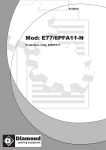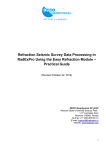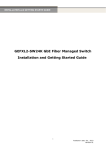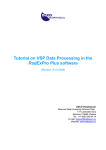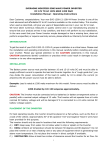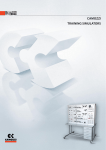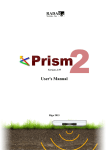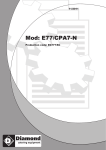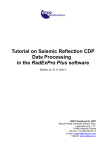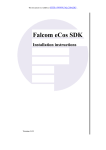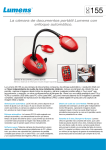Download QC seismic software
Transcript
RadExPro seismic software QC comprehensive processing of near-surface seismic data RadExPro VSP data processing seismic software field processing and QC of 2D/3D seismic data on Windows The RadExPro is a friendly and easy-to-use software on Windows for comprehensive and efficient processing of seismic data. The installation process is easy and straightforward. The software does not have any specific requirements to the hardware. It runs smoothly on just ordinary laptop or desktop computers. imaging ensure more reliable and accurate result. Algorithms of spectral whitening, F-X deconvolution, frequency dependant noise attenuation and others give you more options for efficient reflection data processing. All standard algorithms of seismic processing are included. Moreover, some innovative highly efficient routines available in the RadExPro are not always present even in “big” processing systems. The software is designed in a way that you will readily understand the logic behind it. In the year 2012 we have implemented a number of updates and improvements aimed to help you working more efficiently and delivering faster. Get aquatinted with the free trial version of the software, read the detailed user manual and study free tutorials downloadable from our web-site: www.radexpro.com. These include completely renewed Screen Display module that is turned now into a powerful interactive tool for fast data display and analysis. When you buy the software we will offer you free training at our office in Moscow (training at your location can also be arranged). The training can be based on your data. New interactive modules for assigning geometry to near-surface onshore and offshore data make this process really fast and intuitive. Joint inversion of the fundamental and higher modes of Rayleigh wave in the MASW module together with different methods of dispersion You will learn RadExPro easily Moreover, the price of the software license includes one year of free maintenance. We will be happy to answer your questions and provide you with free updates as soon as we release them. Reflection Data Processing and Interpretation........................ Flexible and efficient for both impulsive and vibroseis data Refraction Data Processing................................................. Make it quick and easy Multichannel Analysis of Surface Wave (MASW)......................... Competent reconstruction of S-wave velocities QC and Field Processing of 2D/3D Seismic Data.................... Comprehensive QC capabilities on just a conventional laptop VSP Data Processing................................................................. High quality result — the easy way! Demultiple and Deghosting of Hi-Res Offshore Data.............. Multiples and ghosts on single-channel records are not a problem anymore Interactive Display and Analysis.............................................. Fast and impressive! List of Capabilities........................................................................... Everything you need and even more About Us.......................................................................... DECO Geophysical Software Company — an independent vendor of seismic software QC Reflection Data Processing and Interpretation The RadExPro provides effective tools for processing of high-resolution reflection seismic data, both off-shore and on-shore, with either impulsive or swept (vibroseis) source. Input data from one of the many standard formats supported. Those inculde SEG-Y, SEG-2, SEG-D, SEG-B, SEG-1, etc. Besides, any non-standard demultiplexed data format can be easily defined and handled, including customizable trace header structure definition. Most of the standard number representations with any byte order are supported. A "nearly-SEG-Y-but..." file is not a problem anymore. Read geometry from original trace headers, import it from ASCII or SPS files, or easily define using one of the intuitive geometry input modules provided for typical acquisition scenarios: In case of more sophisticated/experimental acquisition schemes, you can always precisely define data geometry using mathematical formulas in the built-in equation calculator. You can also edit and manipulate with the values directly through the built-in Geometry Spreadsheet editor. It is handy and really flexible. Flexible and efficient for both impulsive and vibroseis data Sort your data right on the input to a processing flow. There is no need to re-sort it beforehand, you just get the data sorted properly exactly when you need. For deep seismic data, one can also eliminate ground-roll using one of the frequency dependant noise attenuations algorithms available. Exploit the power of more than 100 highperformance routines readily available for a sophisticated processing expert, including various filters, amplitude recovery algorithms, static corrections, deconvolutions of several types, spectral transforms, migrations, etc. Enjoy intuitive and convenient interactivity of the stacking velocity analysis (both conventional and horizon-based). Observe how the hyperbolas are flattening by NMOcorrection in the real time while you are picking a velocity function. For really big data volumes there is a dedicated quick resort utility that utilize all RAM available in the most optimal way to ensure the fastest possible resorting. Efficiently suppress ground-roll with F-K filtering. Once created interactively, the filter polygon can then be applied to all of the data in a processing flow. Additional options include polygon mirroring and fan filtering with optional wrapping. The resulting stack can be further improved with migrations, F-X predictive filtering and spectral shaping routines. Now you are ready for interpretation. Pick horizons easily, smooth them and export to ASCII and DXF files or make grids and plot them on the map within the software. Refraction Data Processing Easy Refraction — new simple tool for quick and easy processing of seismic refraction data implements the conventional reciprocal inversion method. Load all travel times to Easy Refration module as one pick. Display and analyze them efficiently using intuitive user interface of the module. Input seismic data (all shot points at once) from one of the many standard formats supported. Those inculde SEG-Y, SEG-2, SEG-D, SEG-B, SEG-1, etc. Read geometry from original trace headers, or assign it using our intuitive geometry input module. Check the miss-tie of the reciprocal times and easily correct it when needed. Pick all first arrivals at once on one and the same display panel. Analyze the difference between two time curves: if diving waves are registered in the first arrival, the entire difference graph will be a decay function; if refracted head waves are registered, the function will decay at first, but then will become constant. Make it quick and easy Assign segments of the time curves to different layers using handy visual marker of variable diameter. Click just one button to run the inversion. Adjust the marker size to make it bigger when you need to work faster or smaller for resolving fine details. Preview apparent velocities at the segments being selected at the real time. Draw the first layer: Then the second one: Feel like you need more control? Carry out all processing stages manually. Create composite time-curves, level reciprocal times, analyze velocities and time-depth functions and build refraction boundaries, enjoying full control over the result at every single stage. You can work with individual curves for the most accurate result or draw the layers at all of them together to make the things faster: Export the resulting layered model of the subsurface to ASCII or DXF. Multichannel Analysis of Surface Wave (MASW) A dedicated module for Multichannel Analysis of Surface Wave (MASW) available in the RadExPro provides means for easy and competent evaluation of S-wave velocities of the subsurface. You may want to see the data in the Screen Display, to analyze apparent velocities, spectrum, and, if you like, define horizons for muting. Compatible with any 2D geometry. FV and FK dispersion images calculated independently – you get the best of both. Joint inversion of fundamental and higher modes, unlimited number of modes allowed. Exceptionally user-friendly design – you will enjoy it! Input data from one of the many standard formats supported. Those inculde SEG-Y, SEG-2, SEG-D, SEG-B, SEG-1, etc. Besides, any non-standard demultiplexed data format can be easily defined and handled, including customizable trace header structure definition. Read geometry from original trace headers, or easily define it using our intuitive NearSurface Geometry Input module: Calculate dispersion images for each seismic gather in both FV and FK domains independently. Pick dispersion curves of the fundamental and higher modes in any of the domains. Convenient semiauthomatic picking algorithm will help you making quick and accurate dispersion curve extraction: Competent reconstruction of S-wave velocities You don’t need to save each curve individually – when you are ready with all picks just click Add all curves button to send all of them to the inversion. Then you can always switch any of them off through the MASW Manager dialog: You have been playing with model parameters for one seismic gather for quite a while trying all combinations and finally secured a result you are happy with... but for this single gather only. Why not to use this result now as the initial model for all other gathers, and then invert all of them at once automatically? Yes, you can do this with the RadExPro! Next stage is inversion: you need to find a model of S-wave velocity distribution with the depth that gives you dispersion curves most similar to those you have extracted. With the RadExPro you can jointly invert dispersion curves extracted for all modes, or specify any combination of the modes for the inversion. You may wish to invert, first, the fundamental mode only, and then use the result as the initial model for joint inversion. Feel free to experiment and see what works better in your case. Just one click to run the inversions of all dispersion curves extracted from different gathers. A 2D profile of share-wave velocities is a result of interpolation between the individual vertical velocity profiles. Now the resulting Vs profile can be corrected for the topography and printed or exported to ASCII or GRD files. QC QC and Field Processing of 2D/3D Seismic Data The RadExPro software provides everything needed for efficient seismic QC and field processing on Windows: Rapidly input the data of any size. Assign geometry using the handy and flexible tools provided, including import from SPS and UKOOA p1-90 files. Interactively define different QC polygons of arbitrary shapes for different parts of seismic record. Evaluate all important QC attributes within the polygons: signal to noise ratio, amplitude and frequency content, and more. Easily calculate combined attributes, attribute ratios etc. Plot geometry on cross-plots and coverage maps. Make geometry QC based on analysis of first arrivals. Rapidly resort huge data volumes using a dedicated module with optimized random access operations. Inspect the data using our really fast display tool, analyze spectrums and check trace header fields of any trace when needed. Interactively estimate velocities for all types of waves. t0 = 2504.0 ms v = 2.580 m/ms fi = 0.0 Additionally, you can calculate a number of attributes poststack – in time-windows along arbitrary horizons. Comprehensive QC capabilities on just a conventional laptop Display attribute graphs on top of seismic sections. Display attribute maps using topography as a background. Exploit all necessary tools readily available for field processing until a brute stack: trace editing, bandpass and 2D filtering, amplitude corrections, deconvolutions, interactive velocity analysis, static and NMO-corrections, stacking, 2D and 3D post-stack migrations, and more. Analyze attribute relationships on linked cross-plots and histograms. For example, make signal to noise histogram to be the color-code for all cross-plots to identify bad shots and bad channels. Easily install the RadExPro on a conventional laptop or just an average PC and take into a field or on board a seismic vessel — it does not make any specific requirements to the hardware. And leave your skillful system administrator at the main office – the software runs on Windows. VSP Data Processing With the RadExPro software, you can process zero-offset, far-offset and walk-away VSP data of different types of sources. Make individual bandpass filtering in windows of arbitrary shape. Below is the raw data with strong noise in the upper part of the section that is to be filtered out: Be experimenting all the time! Change the order of procedures and their parameters, switch between the results of different processing and compare them, until you finally end up with the processing flow you are really happy with. Then simply drag-and-drop the resulting flow to copy all its procedures and parameters and apply the same processing to another dataset. Assign geometry using a dedicated easy-touse tool, properly incorporating inclinometry data and removing duplicated traces. Separate different components. Select the one you want to use now just in few clicks. Use all three components for 3C polarization analysis and rotation to make sure that full seismic vector response is available for efficient processing. Here is the result of high-pass frequency filtering in the upper window: High quality result — the easy way! Separate the upgoing and downgoing P- and S-wavefields using the exhaustive set of processing algorithms available. Tie VSP and seismic data and interactively determine static shifts required. Interpret the data interactively to produce reliable velocity model and immediately compare it with the logging data. Calculate migrated VSP-CMP sections and compare them in 2D or in 3D. Save your model and easily re-open it for interactive edit. Never get lost in your old projects. Any dataset is stored together with its history, readily showing you all processing procedures applied and all their parameters. Export velocities and travel times to an ASCII file. Demultiple and Deghosting of Hi-Res Offshore Data Challenge — demultiple of single channel marine data Several techniques of multiple suppression are well known to work with 'big' full-offset marine seismic data, including Radon demultiple, SRME, Tau-P deconvolution, etc. However, efficient suppression of multiple reflections on high-resolution offshore seismic data acquired with one or just a few channels at zero or small offsets have been a deep problem until now. Predictive deconvolution, the mainstay of single-channel marine demultiple processing, in most cases is nearly useless. It either does not affect the strongest multiples or erases a blank gap around the unwanted event killing all adjacent reflections. Solution — new efficient algorithm The RadExPro software now provides a new efficient demultiple algorithm for near-offset single-channel or stacked offshore seismic data. The algorithm is implemented in a brand-new processing module called Zero-Offset DeMultiple. It brings really amazing results being capable in many cases to significantly suppress multiples without disturbing crisscrossing useful reflections. Examples are shown on the right. Principal multiple reflections are indicated with arrows. Note the primary reflections interfering with the multiples. When the multiples are significantly suppressed, the interfering primaries are still there and not disturbed. Multiples and ghosts on single-channel records are not a problem any more How does it work? Deghosting The algorithm is based on adaptive subtraction of a model of multiples from the original wave field. The model is obtained from the data itself either by static shift of the original traces or by auto-convolution. However, what makes the algorithm that effective is the adaptive subtraction approach used. Ghost waves is another traditional problem for a marine seismic processor. Depending on the towing depths of the source and the streamer you can get several ghosts following each reflection. These reduce vertical resolution of the data and may lead to misinterpretaion, looking like fake layers. In general terms, a dedicated shaping filter is calculated for each trace basing on both the original data traces and the model traces. This filter, when applied to the trace, is trying to minimize the RMS amplitudes of whatever is found similar between the trace and the model. When the filter is calculated it is accounted for non-stationarity to make it adaptive to the events that are quite similar but not exactly the same. This makes the subtraction impressively efficient even for rather approximate models when the arrival time or/and the amplitude of the modeled multiple differ from the actual observation. Suppression of ghost waves is difficult because their amplitudes are nearly the same as those of the primaries, while the arrival time delay is small and varies depending on ship speed and towing conditions. The RadExPro offers a dedicated module that allows for efficient deghosting of the data without disturbing the interfering primary reflections and not affecting the original wavelet. The technic is based on the adaptive subtraction algorithm. BEFORE The algorithm is implemented as a single processing routine with simple user-friendly interface: AFTER Interactive Display and Analysis Completely renewed in the year 2012, the Screen Display module is a powerful tool a powerful interactive tool for fast data display, interactive analysis and interpretation. Interactively define QC polygons for calculating various attributes for different parts of seismic records. spectrum of signal Estimate apparent velocities of all types of waves interactively. With the new Screen Display you can: Display WT/VA data on top of the colorcoded velocities or seismic traces. Pick faster and more accurate with improved autopicking facility. Undo/redo pick editing. Smooth picks with smoothing average. Pick horizon for top muting on one single gather and then simply project it to all other gathers with only 2 mouse clicks. Analyze spectrums from arbitrary windows and always observe where exactly your spectrums were taken from. Analyze FK spectrums and interactively define FK filter polygons. Never get lost in between of several Screen Display windows while testing processing parameters with the new Flow History facility. ...and much much more. Fast and impressive! Enjoy intuitive and convenient interactivity of the stacking velocity analysis. Pick and observe linear objects in 3D display. Map horizons and attributes. Need more details? Get more accurate knowledge of velocities along key horizons using the Horizon Velocity Analysis. Select an arbitrary line on the interactive map and display the data of several lines on one panel. Export horizons to ASCII or DXF-files. Improve geological understanding of the data to make interpretation easier and faster using impressive 3D display. Print processing results together with horizons, attribute graphs and decoration. Preview you prints to make sure that you get exactly what you need. List of Capabilities Configurations Start Professional I/O Input data from SEG-Y, SEG-D, SEG-2, SEG-B, SEG-1, SCS-3, Diogen files, with optional header remaping Input GPR data from LOGIS, Zond, RAMAC/GPR, GSSI, Pulse EKKO formats Input trace from ASCII file Input data from user-defined demultiplexed format with trace header information Reading data from tapes Data output to SEG-Y files Export horizons to ASCII and DXF files Output data to ASCII file Geometry assignment Import from ASCII and SPS files Calculation using built-in equation calculator Display and editing using built-in spreadsheet editor Dedicated module for near-surface geometry assignement Dedicated module for marine geometry assignement Dedicated module for VSP geometry assignment 3D binning + + + + + + + + + + + + + + + + + + + + + + + + + + + + + + + + + + + + + + + + + + + + + + + + + + Amplitudes Amplitude corrections: linear (spherical divergence), exponential, automatic gain control (AGC), trace equalization, time-variant gain Ensemble equalization DC removal Statics Elevation statics calculation Residual statics calculation Correlation statics calculation Apply statics Deconvolutions and spectral shaping Signature Zero-phase Predictive Spiking Surface-consistent Nonstationary predictive F-X (predictive filtering) Phase Optimal filtering Spectral whitening Spectral shaping + + + + + + + + Interpolation Trace interpolation along the line Interpolation of set of 2D lines into a 3D volume + + + Everything you need and even more Configurations Start Professional Filtering, trace transforms and trace math Frequency filtering: trapezium bandpass filter Ormsby bandpass filter Butterworth filter notch filter 2D filtering F-K filtering F-X predictive filtering (F-X deconvolution) Radon transform (direct and inverse) Amplitude spectrum calculation Phase spectrum calculation Autocorrelation and crosscorrelation functions Logarithm and exponent of trace Adaptive wavefield subtraction Convolution Trace/trace and trace/scalar arithmetic Power of trace Radial trace transform (direct and inverse) Burst noise removal Frequency dependant noise attenuation Time frequency domain noise rejection Trace editing Resample Kill trace Zero-padding Inverse Muting Trace length change Header fields manipulations Mathematical operations Spreadsheet editor Import from ASCII and SPS files, export to ASCII Smoothing average Shift of header values to specified number of traces Surface-consistent calibration (e.g. for static shifts or amplitude values) Graphs Cross-plots and histograms + + + + + + + + + + + + + + + + + + + + + + + + + + + + + + + + + + + + + + + + + + + + + + + + + + + + + + Time-depth conversion Conversion between time and depth domain using different types of velocity functions + + + + + + + + Migrations F-K Stolt migration 3D F-K Stolt migration T-K migration Configurations Velocities and CDP stacking 3D CDP binning CDP gathers Super gathers Interactive analysis of stacking velocities Horizon-based velocity analysis NMO-correction Stacking Start Professional + + + + + + + + + + + + Offshore data processing Marine geometry assignment Dropped/missed shots correction Import tide statics Suppression of multiples on high-resolution near-offset marine data Deghosting + + + + + + + + QC and attribute analysis Analysis of attribute dependancy on linked cross-plots and histograms Mapping attributes on top of topography background Estimate of average, RMS, minimum, maximum, absolute maximum amplitude post-stack within a window along a horizon Determination of time of maximum, minimum, and absolute maximum amplitude post-stack within a window along a horizon Estimate of peak frequency, apparent frequency, visible frequency, centroid frequency, and frequency bandwidth post-stack within a window along a horizon Estimation of signal-to-noise ratio post-stack within a window along a horizon Ensemble QC: estimation of mean, 2D RMS and mean 1D RMS amplitude, signal-tonoise ratio, resolution and apparent frequency pre-stack within an arbitrary polygon Computation of auto-correlation and cross-corelation functions Interactive estimate of velocities of all types of waves Calculation of effective fold Reflection strength, instantaneous frequency, instantaneous phase + + + + + + + + + + + + + Refraction Processing time-curves of refracted waves (CRM) Processing time-curves of diving waves + + + + + + + + Vibroseis Correlation Surface Wave Analysis Multichannel Analysis of Surface Wave (MASW) Standard configurations: —Start - basic processing of 2D near-surface seismic reflection data, refraction seismic data processing, analysis of surface wave (MASW) ; —Professional - advanced processing of 2D/3D near-surface reflection data, field processing and QC of deep 2D/3D seismic data, processing of refraction seismic data, analysis of surface waves (MASW), processing of VSP data. Configurations Start VSP Professional + + + + + + + + + + + + VSP geometry assignment for vertical or inclined wells Polarization analysis, 2C and 3C rotation Generation of synthetic seismograms for different wave types Separation of wavefields of different wave types Calculation of arrival time of direct wave or reflected wave from a specified reflector for horizontal layered model Layer velocity modeling Estimation of Q Far-offset VSP NMO-correction Import of well-log data, import and export of velocity models Joint interpretation of VSP, logging, and seismic data VSP Kirchhoff migration VSP-CDP transformation Display and printing Various modes of data display Display of WT/VA traces on top of color-coded velocity or seismic data Support of several data displays at a time, several datasets in one display Interactive calculation of frequency spectrum and F-K spectrum of arbitrary data fragment Display of trace header fields Display of lines, attributes, horizons, on the interactive map Interactive display of data along an arbitrary line selected on the Map 3D display of a set of 2D lines, with optional semi-transparent map on top Picking linear objects in 3D Display of attributes on linked cross-plots and histograms Printing and export of cross-plots and hystorgams to a bitmap Printing of processing results with print preview Data and processing management Processing within projects. A project can be easily moved to a new location together with all associated data and processing parameters Work with several projects at a time Processing flows can be combined into several queues and run in parallel Processing flows can be copied with all procedures and parameters Processing history Data run-time resorting on input into the flow Fast resorting of big data volumes Combining several flows into processing queue, parallel execution of several queues + + + + + + + + + + + + + + + + + + + + + + + + + + + + + + + + + + + + + + + + Interpretation Horizon picking, manual and automatic Griding of horizons and attributes Attribute calculation along horizons Simultaneous display of different types of data on the map and in 3D display System requirenments *The list of capabilities is for information only and is subject to change without prior notice. The software works at any CPU of x86 or x86-64 architecture, however the software code is optimized for Intel Pentium™ 4 and higher set of commands. Most resource-consuming routines are parallelized to take advantage of the modern multi-processor workstations under MS WindowsTM Recommended minimum: Intel Core 2 Duo CPU 2 GB RAM MS Windows XP/Vista/7 1280x1024 monitor About Us Founded by a professor of Lomonosov Moscow State University and some of his former students, DECO Geophysical Software Company in an independent producer of seismic software on Windows. We develop and distribute the software presented here as well as elaborate new algorithms and technologies for geophysical data processing. We are 7 people based in Moscow, Russia. The RadExPro software took its origin in 1992 at the Geophysical Department, Faculty of Geology, Lomonosov Moscow State University. Since then, it has been continuously developed and advanced. When the DECO Geophysical company was founded, the software transferred to the company together with its initial authors. Since 1992, more than 500 licenses of the RadExPro software have been sold worldwide. Our software is used by numerous geotechnical, survey and service companies as well as in educational and academic institutions. Our partners You can buy the RadExPro software from our representatives world-wide: Contacts In case of any questions, please contact us: DECO Geophysical SC Postal address: Moscow State University Science Park, Leninskie Gory, 1-77, 119992 Moscow, Russia In Americas Paulsson, Inc. (PI) www.paulsson.com In Asia China Beijing Orangelamp Navigation Technology Development Co., Ltd www.orangelamp.com.cn Visiting address: 57A, Vavilova st. Moscow, Russia India Essem High Tech Pvt.Ltd www.essemhightech.com Tel. (+7 495) 987 22 47 / (+7 495) 930 83 59 Fax (+7 495) 930 80 58 Japan Terra corporation www.terrajp.co.jp Sales: [email protected] Support: [email protected] Korea C & H, Inc. www.candh.co.kr Middle East Geomorph Instruments www.geomorph.gr Singapore and ASEAN countries Sea and Land Technologies Pte. Ltd. (SALT) www.sea-landtech.com.sg In Europe Germany DMT GmbH & Co. KG www.summit-system.de (dedicated customized configuration only) GeoHiRes International Ltd. www.geohires.com Greece and Southern Europe Geomorph Instruments www.geomorph.gr Italy Codevintec www.codevintec.it Norway P-Cable 3D Seismic AS www.pcable.com (dedicated customized configuration only) Russia Geotech www.geotech.ru LogSys www.logsys.ru Geosignal www.geosignal.ru Softline www.softline.ru Get Free Trial Here: www.radexpro.com
























